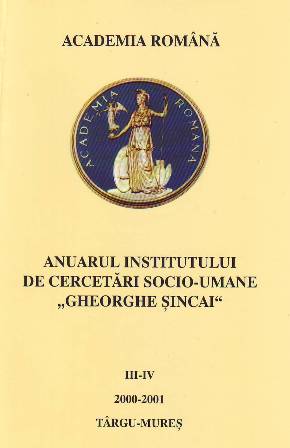„Problema evreiască” în context multietnic: Transilvania interbelică
„The Jewish Problem” in a Multiethnic Context: The Interwar Transylvania
Author(s): Maria GhittaSubject(s): History
Published by: Institutul de Cercetări Socio-Umane Gheorghe Şincai al Academiei Române
Keywords: Transylvania; 1918; the Great Union; the „Jewish question”; the multiethnic experience; the relations between Romanians and Hungarian; anti-Semitism; the East; the West; the Other; the Berlin Treaty (1878)
Summary/Abstract: Transylvanian’s integration in the Romanian State after 1918 raised a series of problems, whose treatment wavered between the underlining (the maintenance) of the local specificity and the unifying tendency. The „Jewish question” is one of them. The present study examines the specificity brought about by the multiethnic experience (but in fact visibly bipolarized: Romanians-Hungarians) in the relation to the Jews and in the functioning of anti-Semitism. The Transylvanian space is frequently perceived as the impact point of what is generally called East and West. In the case of the Jews, this meant, for example, that there existed eastern type communities as well as western ones, differentiated on the demographic, social, cultural, religious level. The question that rises is in what measure the „others” distinctly perceived them. It is certain that for the Transylvanian Romanians it was a constant concern due to their poor presence in towns, social, economic positions or in trades, where the minorities (either Hungarian or Jewish) were better represented. Transylvania after 1918 was also the place where met two considerably different government policies applied to the Jewish question. If for the modern Romanian State, the Jewish question was a constant on the internal agenda, but mostly on the international one, and particularly after the Berlin Treaty (1878), the Hungarian State built at approximately the same period (the last decades of the 19th century), what would be known as the „Hungarian success”. The Jews from Hungary acquired at that moment the full civil and religious equality, and many of them acquired something more: the feeling of belonging to the Hungarian nation. It can be said, I believe, that for the Romanians, the way Jews were perceived and the relation to them (the negative one, especially) was taking place in the frame of a triangle, which unveiled in specific situations, a nationalism’s triangle (Romanian-Jewish-Hungarian).
Journal: Anuarul Institutului de Cercetări Socio-Umane »Gheorghe Şincai« al Academiei Române
- Issue Year: 2001
- Issue No: 03+04
- Page Range: 98-105
- Page Count: 8
- Language: Romanian

